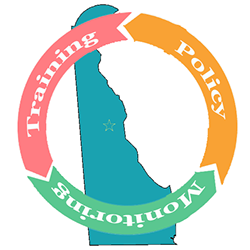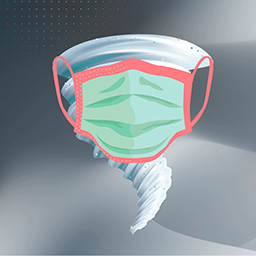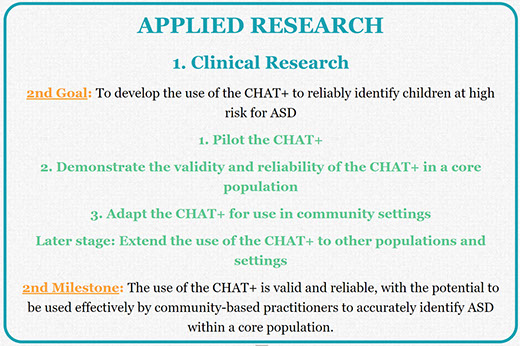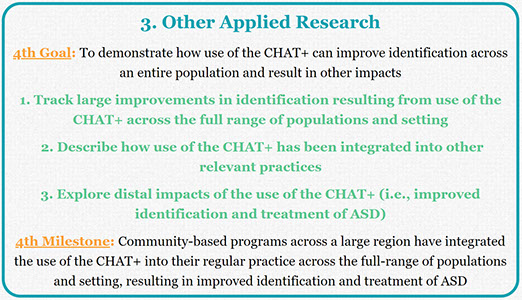Train & Hope??
![]() Training is necessary but often insufficient to ensure adoption of new practices.
Training is necessary but often insufficient to ensure adoption of new practices.
White elephant
![]() Create effective, sustainable programs before sinking money into a new building.
Create effective, sustainable programs before sinking money into a new building.
Implement, baby, implement
![]() Is traditional autism research becoming a bridge to nowhere?
Is traditional autism research becoming a bridge to nowhere?
Research to guide services
AutismSpectrumNewsNot all research is equally relevant to those focused on providing services.
A Network on Excellence
 Can statewide training increase expertise and capacity, and bridge gaps?
Can statewide training increase expertise and capacity, and bridge gaps?
A Bus to Betsy's
 The nominee to lead special education in the US could send it back to the Stone Age.
The nominee to lead special education in the US could send it back to the Stone Age.
The Business of innovation
 New services are shaped not by research but by available funds, staff, and expertise.
New services are shaped not by research but by available funds, staff, and expertise.
Margot votes! Will others?
 Learn how people like Margot exercise their right to vote in the 11 states that allow it .
Learn how people like Margot exercise their right to vote in the 11 states that allow it .
CoVid's silver lining
 Insights into the isolation and costs of disability might finally spur policy changes.
Insights into the isolation and costs of disability might finally spur policy changes.
A State of Synchro
The magic of teaching someone like Margot to ski mobilizes a remarkable army.
A Drop in the Bucket
New data suggests ASD research has little impact on improving identification.
A drop in the bucket
New analyses of $2.5 billion of research funded between 2008 and 2015 suggests that ASD research may have remarkably little immediate or direct impact on improving identification
June 20, 2019
 Across this site, we have sought to understand why so many people with ASD and related conditions have seen so little benefit after decades of research and advocacy. These gaps are especially striking with respect to the marginal improvements in early identification, and the wide variations in ASD identification from state to state and across different groups.
Across this site, we have sought to understand why so many people with ASD and related conditions have seen so little benefit after decades of research and advocacy. These gaps are especially striking with respect to the marginal improvements in early identification, and the wide variations in ASD identification from state to state and across different groups.
One solution we recently proposed is a research roadmap that charts the progress from basic research into the causes and characteristics of ASD, to applied research into specific practices. The latter includes clinical research demonstrating effective new practices, and implementation research documenting how community-based programs can utilize these new practices to begin to improve outcomes on a meaningful scale. This roadmap helps to align each stage of research with the other elements in the network of services, training, and policy that have the potential to shape outcomes at the state and even national level. We have begun to validate this roadmap by applying it to 25 years of research on the CHecklist for Autism in Toddlers and its variants.
In addition, we recently applied this roadmap to research aimed at improving identification of ASD, and presented the results at the 2019 annual meeting of the International Society for Autism Research. The principle findings are summarized below, while a more complete handout including other analyses is available elsewhere.
In this study, we re-assessed the allocation of more than $2.5 billion of ASD research funding from all major public and private funders in the US from 2008 to 2015. Our goal was to conduct a project-by-project review of grants likely to involve applied research, to identify those projects with a primary objective that involved testing and improving actual clinical practices centered on ASD screening and diagnosis. We also wanted to understand the knowledge impact of these projects, or the number of projects that yielded at least one directly relevant publication. We considered a publication to be directly relevant if it reported the results of the primary hypothesis, test, or goal stated in the original grant application.
We found that 11% of all research funding (about $277 million) was directed towards improving ASD identification (see below). About 14% of this funding ($38 million) involved directly testing specific clinical practices to improve ASD screening or diagnosis. The knowledge impact of these investments was even more limited: fewer than one half of these projects appeared to have resulted in a directly relevant publication. Thus, the actual knowledge impact of research to improve ASD identification - a persistent area of concern for researchers and advocates alike for at least two decades - remains a drop in the bucket.
Related Content
On this site
A Research Roadmap based on the CHAT+
Hover over phases for details
APPLIED RESEARCH

BASIC RESEARCH

1. Clinical Research

2. Implementation Research

3. Other Applied Research
ASD research funding from 2008-2015: $2.5 billion
$$$$$$$$$$ $$$$$$$$$$ $$$$$$$$$$ $$$$$$$$$$ $$$$$$$$$$ $$$$$$$$$$ $$$$$$$$$$ $$$$$$$$$$ $$$$$$$$$$ $$$$$$$$$$
All basic and applied research to improve identification: $277 million over 399 projects
$$$$$$$$$$ $
Applied research to improve identification: $38 million over 42 projects
<$$
Applied research to improve identification that yielded directly relevant publications: 20 projects
<$
These findings indicating relatively little investment into applied research on identification, combined with the limited knowledge impact, may begin to explain the persistent and significant gaps in timely and accurate ASD identification across the US. Future analyses may reveal other gaps... How many projects yielded specific recommendations that practitioners or program leaders found useful? To what extent can researchers demonstrate that their findings have impacted practices used by programs in their own community? And how many basic research projects led to applied research that tested new practices?
Train & Hope??
![]() Training is necessary but often insufficient to ensure adoption of new practices.
Training is necessary but often insufficient to ensure adoption of new practices.
White elephant
![]() Create effective, sustainable programs before sinking money into a new building.
Create effective, sustainable programs before sinking money into a new building.
Implement, baby, implement
![]() Is traditional autism research becoming a bridge to nowhere?
Is traditional autism research becoming a bridge to nowhere?
Research to guide services
AutismSpectrumNewsNot all research is equally relevant to those focused on providing services.
A Network on Excellence
 Can statewide training increase expertise and capacity, and bridge gaps?
Can statewide training increase expertise and capacity, and bridge gaps?
A Bus to Betsy's
 The nominee to lead special education in the US could send it back to the Stone Age.
The nominee to lead special education in the US could send it back to the Stone Age.
The Business of innovation
 New services are shaped not by research but by available funds, staff, and expertise.
New services are shaped not by research but by available funds, staff, and expertise.
Margot votes! Will others?
 Learn how people like Margot exercise their right to vote in the 11 states that allow it .
Learn how people like Margot exercise their right to vote in the 11 states that allow it .
CoVid's silver lining
 Insights into the isolation and costs of disability might finally spur policy changes.
Insights into the isolation and costs of disability might finally spur policy changes.
A State of Synchro
The magic of teaching someone like Margot to ski mobilizes a remarkable army.
A Drop in the Bucket
New data suggests ASD research has little impact on improving identification.
X
My Related Publications
 (2019). A systematic review of research involving ASD screening tools: A roadmap for modeling progress from basic research to population impact. International Society for Autism Research, Montreal, CA. May. View handout.
(2019). A systematic review of research involving ASD screening tools: A roadmap for modeling progress from basic research to population impact. International Society for Autism Research, Montreal, CA. May. View handout.
 (2019). Clinical research to develop tools to improve ASD Identification: A comprehensive review of projects funded in the US from 2008 to 2015. International Society for Autism Research, Montreal, CA. May. View handout
(2019). Clinical research to develop tools to improve ASD Identification: A comprehensive review of projects funded in the US from 2008 to 2015. International Society for Autism Research, Montreal, CA. May. View handout
 (2019). Implementation research designed to improve ASD Identification: A comprehensive review of projects funded in the US from 2008 to 2015 International Society for Autism Research, Montreal, CA. May. View handout.
(2019). Implementation research designed to improve ASD Identification: A comprehensive review of projects funded in the US from 2008 to 2015 International Society for Autism Research, Montreal, CA. May. View handout.